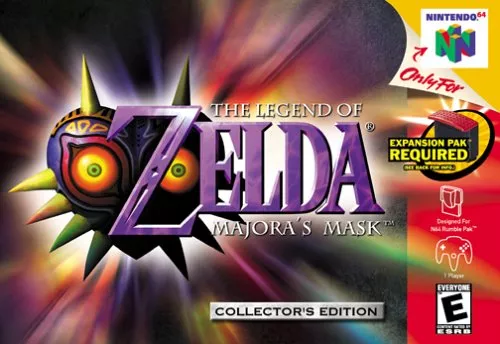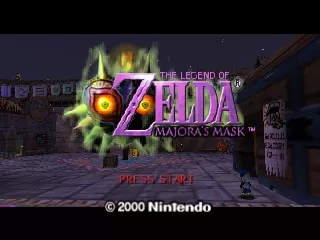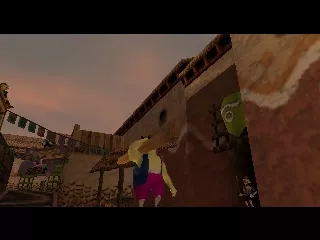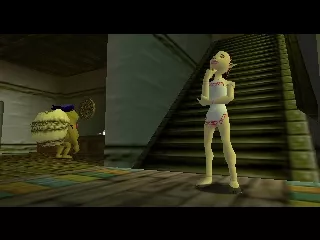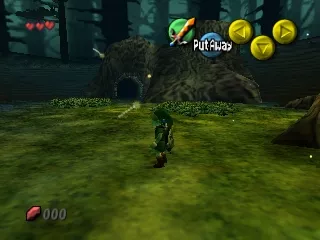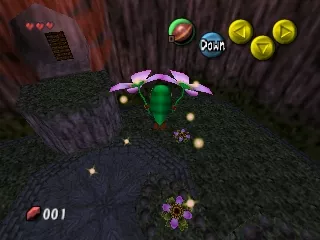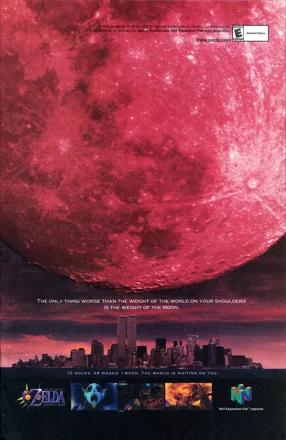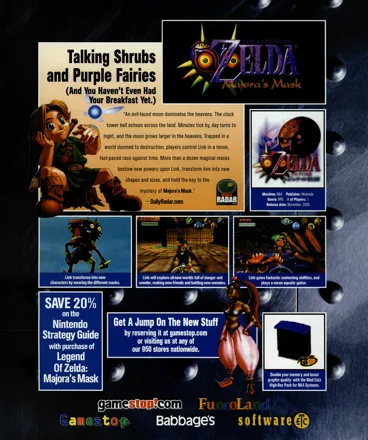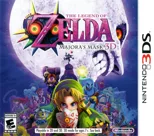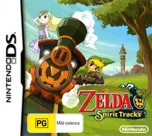The Legend of Zelda: Majora's Mask
Description official descriptions
After having fulfilled Princess Zelda's request and saved the land of Hyrule from grave danger, Link departs on his horse Epona. In the Lost Woods he is ambushed by Skull Kid, an imp who dons a mysterious mask, accompanied by the fairies Tael and Tatl. Skull Kid turns Link into a small plant-like creature known as Deku Scrub and takes away his horse and his magical ocarina. Shortly afterward Tatl joins Link and agrees to help him revert to his native form. A meeting with a wandering mask salesman reveals that the Skull Kid is wearing Majora's Mask, an ancient item used in hexing rituals, which calls forth a menacing moon hovering over the land of Termina. Link has exactly three days to find a way to prevent this from happening.
Majora's Mask is a direct sequel to Ocarina of Time. It utilizes the same engine and visual style, and virtually identical interface. The game retains the traditional elements of Zelda games (dungeon exploration, sword fighting, bows, bombs, heart containers, etc.) as well as those introduced in its immediate predecessor, such as active blocking with a shield, various throwing items, and the usage of melodies played on the ocarina to solve puzzles. Compared to the previous Zelda games, this installment is more oriented towards interaction with NPCs and has a larger variety of items, optional quests, and mini-games.
Also unique to this entry is its time system. The game has an internal clock, with one hour roughly corresponding to one real-life minute. If the player hasn't completed all the objectives within three in-game days, the moon falls on Termina, annihilating everyone and ending the game. However, the player can return to the first day at any time by playing a song on the ocarina, saving all quest-related progress and inventory but losing other items such as ammunition or money (unless stored in a bank). It is also possible to learn melodies that slow the time passage significantly or advance the clock instantly to the next day. Some events happen only at specific times, and many characters follow their own schedules throughout the three days. Owl statues scattered across the land provide quick-save points and serve as teleporters between areas when discovered.
Collection and usage of masks play an important role in the game. Most of the twenty-four masks that can be found in the game are optional, and usually serve to solve side quests or enhance Link's abilities, allowing him, for example, to run faster or to become invisible. Transformation masks can be used to turn Link into a Deku Scrub, a Goron, or a Zora. Each of these forms has access to unique abilities, many of which are essential to the completion of the game. Among other skills, Deku Link can shoot bubbles from his mouth and float between flowers; Goron Link can operate heavy switches and walk through lava without taking damage, and weigh down heavy switches; Zora Link can swim fast and generate force fields.
Spellings
- ゼルダの伝説 ムジュラの仮面 - Japanese spelling
Groups +
- Boss Fight Books games
- Console Generation Exclusives: Nintendo 64
- Gameplay feature: Auto-mapping
- Gameplay feature: Day / night cycle
- Gameplay feature: Drowning
- Gameplay feature: Fishing
- Gameplay feature: Horse riding
- Gameplay feature: Photography
- Gameplay feature: Transformation
- Games made into comics
- Games made into stage productions
- Games referenced in movies
- Legend of Zelda series
- Protagonist: Elf
- Theme: Time loop
- Theme: Time travel
Screenshots
Promos
Videos
Add Trailer or Gameplay Video +1 point
See any errors or missing info for this game?
You can submit a correction, contribute trivia, add to a game group, add a related site or alternate title.
Credits (Nintendo 64 version)
106 People (100 developers, 6 thanks) · View all
| Producer | |
| Supervisor | |
| Game System Directors | |
| Script Director | |
| Program Director | |
| Music Composer | |
| Art Director | |
| Cinema Scene Director | |
| Dungeon Director | |
| Memory Management Director | |
| Map Data Managers | |
| Cinema Scene Support | |
| Program Manager | |
| Main System | |
| Display System | |
| Boss Enemy Program | |
| Enemy Program | |
| Program | |
| [ full credits ] | |
Reviews
Critics
Average score: 93% (based on 57 ratings)
Players
Average score: 4.1 out of 5 (based on 154 ratings with 6 reviews)
The Good
This game is a very different approach to making a Zelda game from what I can tell. There is no Zelda, Ganondorf, Triforce, or Master Sword, just a little guy who was thrown into a parallel world in order to save it-- and I absolutely love it. Seeing a Zelda game that is a side-quest to another game with the same Link is always nice to see, especially with Majora's Mask.
You enter this new world with no explanation. All you know is that something terrible will happen in three days, which is hardly any time at all. This is where the Ocarina of Time comes in. You use it to reset the three days and go back to the first day, reverting a good portion of your progress. I have seen several people complain about this time mechanic, but I, personally, like it. It adds a different kind of immersion to this adventure. It makes you have to plan out what you want to do in a matter of three days (luckily, there are two songs that slow down and speed up time, which makes it easier to get things done). Without this mechanic, almost every sidequest would NOT work, since a bunch of them rely on going back, going forward, and experimentation.
The story is very good. To not spoil anything, you are practically thrown the responsibility as the world's savior. The main villain is this mysterious, terrifying, and powerful being. There is just a moon with a face that nobody really pays any mind to. The land is full of mystery, quests and areas will leave the player with questions that may or may not be answered. The best part about the story is how dark it is. Characters die, grieve, and have problems that are worsened by the threat of world destruction. It's a game that is worth exploring and looking around.
A big part of the game is the mask collection. By doing side quests, main quests, and just exploring, you will find masks to add to your collection. Getting a new mask is always satisfying. It's a reward when you do something right.
The Bad
Most of the masks are useless. A lot of the time you use them once, sometimes they can be used to your advantage in combat/exploring, and sometimes they do pretty much nothing. I wish that some of the masks could at least evoke some reactions, or just be used in more ways, but no. I mean hey, it's at least satisfying having a full mask inventory!
Playing songs on the ocarina is really tedious. Every time you play, it plays an encore. This is especially annoying when you want to play the song that slows or speeds time, but you accidentally play the wrong one. It would be nice to have the option to skip or turn off the encore (especially on the Stone Tower).
The Bottom Line
Absolutely try it out. It's an adventure that is well worth your time. The story is really mysterious, which leaves room for speculation. This is a good, and surprisingly dark and creepy game.
Nintendo 64 · by sinisterhippo (23) · 2020
An innovative and wholly clever yet cumbersome Zelda game.
The Good
In 1998 Nintendo released upon the world a Nintendo 64 game so epic, so stunningly beautiful and so carefully crafted it wowed gamers across the globe and gained tremendous praise from gamers and critics alike.
This game was The Legend of Zelda: Ocarina of Time. For its time it was revolutionary. With its large, stunning and open ended 3D world, its loveable characters and the innovative lock-on system Shigeru Miyamoto and his team proved they could translate their awesome Zelda series into 3D without sacrificing anything that made previous titles in the series such a delight to play.
To live up to the expectations made by that game Nintendo had to come up with something very interesting for a new sequel. The result was a game that both succeeded in doing so tremendously well while it also had some frustrating and annoying elements. It's kind of a divisive game among Zelda fans and they hold an ongoing debate whether it or Ocarina of Time is the better game. I am off course talking about one of the most unique and quirky Zelda games: The Legend of Zelda: Majora's Mask.
Released in 2000 it was a game that hit the Nintendo 64 late on in its life cycle. It came out around the same time when Sony released its wildly successful and much wanted PlayStation 2. Some people may have missed it because of this. A shame, really, as it is an incredibly clever and well thought out game, though not without flaws.
It starts only a few months after Ocarina of Time. Protagonist Link is looking for his old fairy buddy Navi when he stumbles upon the mysterious Skull Kid who lures him into a trap and uses the powers of a strange mask, the titular Majora's Mask, to transform Link into a Deku Scrub, a plant-like creature that first appeared in Ocarina of Time. Not only does Link need to find a way to become human again, he also needs to find his way back home as he has been sucked into the mysterious new land of Termina, robbed of his Ocarina of Time.
While walking around as a tiny Deku Scrub in Termina's main town, Clock Town, Link meets the Happy Mask Salesman, a character from the previous game, who urges him to get back Majora's Mask from Skull Kid to prevent its evil powers to spread across the world. He soon discovers there is some serious trouble going on in Termina. The moon, as in: an evil-looking moon with red eyes, is about to crash into Termina within three days, wiping it of the map and all its living creatures with it.
This is all because of the dark powers of the Mask, in which the ancient demon Majora resides. Link soon finds his Ocarina in the hands of the Skull Kid. After playing his healing song to become human again, Link will have to use the Ocarina's time travel capabilities to return to the first day he arrived in Termina to save himself from being crushed by the moon. This is totally different from the usual save-the-princess story seen so many times before and it allows for an unusually dark Zelda game with the constant sense of impending doom looming over everything Link does. Majora is by far the most story-driven Zelda game.
Time travel, that's basically what this game is all about. You play the Song of Time and you go back to day one. This way you can save yourself over and over. Don't have enough time left to beat that dungeon? Just go back in time to restore your time and use warp points to get back to where you ended quickly. You can also play the Song of Time differently to greatly slow down the flow of time or to travel to the future. The downside of this is that your actions never happened if you go back so most of the game will be reset, although you usually can get an item to solve problems in an easier way the next time around.
At first you will be totally confused and not really sure what to do. But after a bit of exploration your main objectives become clear. To get the mask back you will need to awaken four giants in each of the winds four directions.
Across the plains of Termina Field are four regions, each inhabited by a different race. There is a swamp where Deku Scrubs live, a high mountain where the Gorons, the rock people, live, a bay with the Fish-like Zora tribe and finally a dusty canyon where all kinds of undead creatures such as ghosts and zombies reside. At the end of each of these four regions, there is a dungeon. Beat the four dungeons to awaken all four giants.
While four dungeons may seem like nothing compared to Ocarina's nine different dungeons, Majora compensates this by relying much more on side-quests. In this game you have to carefully observe the living patterns of the people living in Termina. The postman's round, the artists rehearsing in Clock Town's back alleys, it all seems completely unimportant until you delve deeper into the game and you find how unique this idea truly is. For example, there is a Goron staying at an inn also called Link. You can travel back in time to use information from the future to your advantage and use your own name to get the key from the reservation counter so you get into the room he was supposed to stay in. Many characters have equivalents in Ocarina and it is especially fun to see the lovable characters from that game as sometimes completely different people. Take Navi the fairy for example. She was rather annoying in Ocarina of Time with her high pitched yelps like "Hey!" and "Look!". She's now replaced by Tatl who's an improvement for sure. There are a few new characters as well, including the very first appearance of Tingle the wannabe-fairy. I like how Termina is both completely different from Hyrule yet eerily similar at the same time.
The NPC quest system also makes the player much more aware of his or her moral dilemmas, and touches upon an emotional level. You can never really save anyone because you will choose to complete different sidequests each time you go back in time. This allows for a rather dark and moody game in the series that surprised gamers back in 2000. Thankfully Link gets a notebook that keeps track of these kind of tasks early on in the game so you can see if you already saved someone in a different timeline.
Many of these side-quests will earn you special masks, while others are obtained by playing through the main quest. These masks play a much more important role than in the previous game. While some just enhance the game in simple ways such as the ability to run faster, others transform link into a Deku Scrub, a Goron or a Zora, each with their own abilities much like in Super Mario games. Many masks, particularly the transformation masks, are vital in progressing through the game and in solving puzzles. Need to be able to dive? Put on the Zora Mask. Need to glide across short chasms? Just whip out the Deku Mask. There are more than 20 in all and while not all are compulsory to beat the game, its fun to collect them all. These masks are very cool and truly enhance the Zelda formula.
The dungeons though, are still where this game truly shines. Particularly the Stone Tower Temple is one of the series' absolute gems. I will not spoil why but play the game and you'll get it. It's just a shame there is so few of them.
The heavy reliance on side-quests also makes this a much more replayable Zelda game. Finding all the weapon upgrades, masks and hearts is going to take a while.
While gameplay is solid, it also looks really good. Graphics are Expansion Pak enhanced and make an already stunning engine even better. There are better looking textures than in Ocarina of Time. Link just looks much better with more polygons and more detailed textures. One of the most visually impressive N64 titles. Even today it holds up pretty well.
The music is a solid mix from tunes from earlier Zelda games as well as new ones. Still as strong as ever! Nice classic effects, such as the puzzle solve sound and the item fanfare are here.
Other than that, everything that made Ocarina of Time such a great game is in here such as ocarina songs, cool weapons, horse riding, mini-games and so on.
The Bad
While this game is probably the most clever Zelda game ever, the bold choices Nintendo made also have some major downsides.
Let's start of with traveling back in time. You lose all consumables such as potions, money, arrows and bombs when traveling back to day one. This is very, very annoying. You can save money on your bank account (that apparently transcends spatiotemporal boundaries) but doing so all the time is cumbersome and should not be a necessity.
But the most annoying thing is the fact that all of the game is practically reset after going back to the first day. Sure, it's a terrific idea at one point making you think about your actions, but it can also frustrate you to death. Usually, newly found items, masks or ocarina tunes let you skip entire parts of the game. However, there are some tasks that need to be done over and over in order to figure everything out and you don't always know whether or not there is an item you should be getting first, let alone how, where or when. You may sometimes make a little mistake and you have to do a lot of work all over again.
The most important example is in the quest with Anju and Kafei, a sort of love tragedy revolving around a young couple about to marry at the festival at the end of the third day. It's a classic Zelda trading sequence, which is cool, but make one little mistake here and you can do it all over again... and again... and again. This frustrated me to no end.
Another thing that I found annoying was the saving system. The game saves your progress if you go back in time, putting you back in Clock Town. You can also save at other locations using owl statues, the warp points of the game. However, the game will take you to the title screen and you can only boot it up once. If you turn of the game after opening an owl statue save file, you get sent back to the last time you saved by going back to day one. I am not sure what they were thinking when they came up with this system.
And then there is the time limit. Sure, it keeps that sense of urgency alive and you can always go back in time. There isn't much trouble with it. That is, until you enter the dungeons. Sure, you can slow down time but even then it is frustrating if you want to figure out how to beat that nasty puzzle while time is steadily running out. And you'll want to collect all the fairies hidden in each temple in one run-through as well so you can get all the important weapon upgrades because if you don't and go back in time, yep!, you lose all of them and the whole dungeon will be reset so getting them all again isn't easy either, even with new dungeon items.
As said, heavy reliance on side-quests goes at the cost of having fewer dungeons. Some may not like the many side-quests.
The Nintendo 64 version requires the purchase of the Expansion Pak. I suggest you just spend your ten bucks on the Virtual Console version instead.
The Bottom Line
That being said Majora's Mask is all in all a fantastic game. It's unique, it's clever, it's pretty and it has a terrific way of telling a story but most importantly; it's fun!
The designers made some bold decisions in this game that work out very well while also come at a high cost, mostly when it comes to the accessibility of the game. This is the reason I still think that in the end, Ocarina of Time is simply the better game. If you never played both games I suggest you play that game first, it will make Majora's Mask more fun to play, anyway.
When all is said and done, Majora's Mask may be a game that's not for everyone, but fans of the series owe it to themselves to at least give this game a try. If you can look past its flaws you will discover what may very well be the most original and clever Zelda game made to this day.
Nintendo 64 · by Rensch (203) · 2010
The Good
Although I never finished the game, I thought that the three day clock was one of the most innovative features of this or any game. It was fun trying to help the characters; I spent most of my time helping people. From what I saw of the dungeons, I thought they were challenging but not too difficult. There were many new enemies. The fighting system remained the same as "Ocarina of Time" which is a good thing.
The Bad
Although some call it "darker", I didn't think it was. The minor characters would say the same thing after you returned to the first day. I hate that I never finished the game.
The Bottom Line
I could't describe the whole game to you since I never completed the game. However, of what I played, I thought it looked a lot like "Ocarina of Time" with a different story.
Nintendo 64 · by gamewarrior (5040) · 2004
Discussion
| Subject | By | Date |
|---|---|---|
| Genre Correction | Mark Picard (1) | Jul 8, 2013 |
Trivia
1001 Video Games
The N64 version of The Legend of Zelda: Majora's Mask appears in the book 1001 Video Games You Must Play Before You Die by General Editor Tony Mott.
Development
As with Ocarina of Time, Majora's Mask was meant to be released for the 64DD add-on, but eventually got crammed into cartridge format. Producer Shigeru Miyamoto originally wanted to re-purpose Ocarina of Time's dungeons into a new game and only gave director Eiji Aonuma a year to create the game. When Aonuma requested that he create a brand new game in the series instead, Miyamoto agreed, so long as the one year deadline remained, creating a rushed development cycle.
Ganondorf
Both this game and The Minish Cap are the only Zelda games in which Ganon/Ganondorf doesn't appear, not counting Link's Awakening in which the shape-shifting final boss assumes his form briefly.
Music
The song Ballad of the Wind Fish previously appeared in The Legend of Zelda: Link's Awakening.
References
Several persons, items and music from The Legend of Zelda: Ocarina of Time return in this game, in either the same or a different role.
References to the game
In the MTV animated series Undergrads, the game's black countdown screen (which greets you at the beginning of each dawn, provided you're not in a dungeon) was parodied with the words "72 HOURS UNTIL THE END OF FRESHMEN YEAR" in the season finale.
Tingle
This game marks the first appearance of Tingle, the strange man who thinks he is a fairy.
Awards
- Electronic Gaming Monthly
- February 2006 (Issue #200) - #155 out of 200 of the "Greatest Games of Their Time"
- Game Informer
- August 2001 (Issue #100) - #68 in the Top 100 Games of All Time poll
Information also contributed by Big John WV, gamewarrior, Mark Ennis, Tiago Jacques and Zovni
Analytics
Upgrade to MobyPro to view research rankings!
Related Sites +
-
Wikipedia: The Legend of Zelda: Majora's Mask
article in the open encyclopedia
Identifiers +
Contribute
Are you familiar with this game? Help document and preserve this entry in video game history! If your contribution is approved, you will earn points and be credited as a contributor.
Contributors to this Entry
Game added by Kartanym.
Wii added by Robond. Wii U added by Michael Cassidy. Nintendo Switch added by Rik Hideto.
Additional contributors: PCGamer77, Exodia85, Sciere, gamewarrior, formercontrib, Patrick Bregger, FatherJack, Deleted.
Game added April 3, 2001. Last modified March 23, 2024.
